(This is edited down and revised from a post I wrote for my old Angelfire website, probably around 2003. The non-public domain images are used to illustrate the subjects and are consistent with fair use doctrine.)
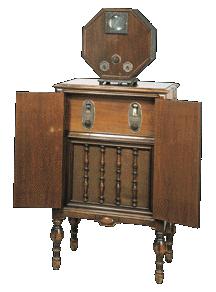
1928 General Electric television
To the untrained eye, antique TVs look like cabinets or radios with little glass screens. Thus, it’s suspected many more mechanical TVs exist than are accounted for in personal collections and museums. To date, there are at least 100.
About 7,000 early electronic televisions (1938–41) were made in the U.S.; 19,000 were made in Britain; and 1,600 were made in Germany. A handful were made in Italy, Russia, France, and The Netherlands. Altogether, there are about 200 verified, surviving American and British sets.
If you know what to look for, you might stumble across one of these beauties in an attic, a flea market, or an antiques shop.
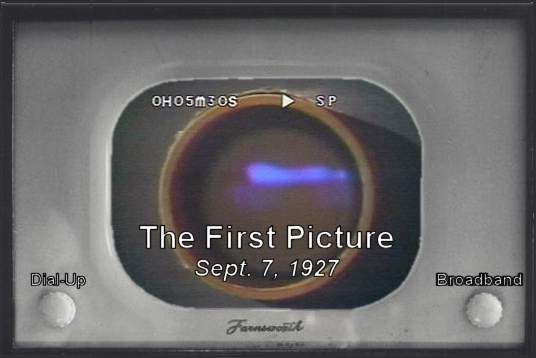
There were dozens of TV stations (all classified as experimental) from 1929–33, and again after broadcasting officially resumed on 30 April 1939. (However, the DuMont 180, the first electronic television, went on sale the year before). Most stations were in New York, Chicago, or New Jersey, with a few from states including Pennsylvania, Oregon, and Missouri.
Some stations were created by avid hobbyists and not credited as official experimental stations, but the frequency travelled for hundreds of miles. Thus, someone in the middle of nowhere could pick up signals from the nearest properly-equipped city.
Decades before TV Guide appeared, there were programming guides issued. Programming tended towards sports, music, variety, plays, and public speeches. Future President Herbert Clarke Hoover and Queen Mary of England also appeared on television in the late Twenties.

Sample 1930 image
There were troubleshooting manuals, instructional guides, and how-to books for building one’s own television. In my second Russian historical, The Twelfth Time, Katrin’s husband Sandro assembles a television set during the annual summer-long vacation to a rented five-story cottage on Long Island in 1928. WRNY is the closest broadcasting station. The assembled viewers see a dancing puppet, followed by moving faces.
When the Konevs are quarantined on account of their children’s whooping cough some months later, Sandro sends over the materials for Ivan to assemble a television set for his own family. My Atlantic City characters, many of whom are rich, also have television sets during this era.
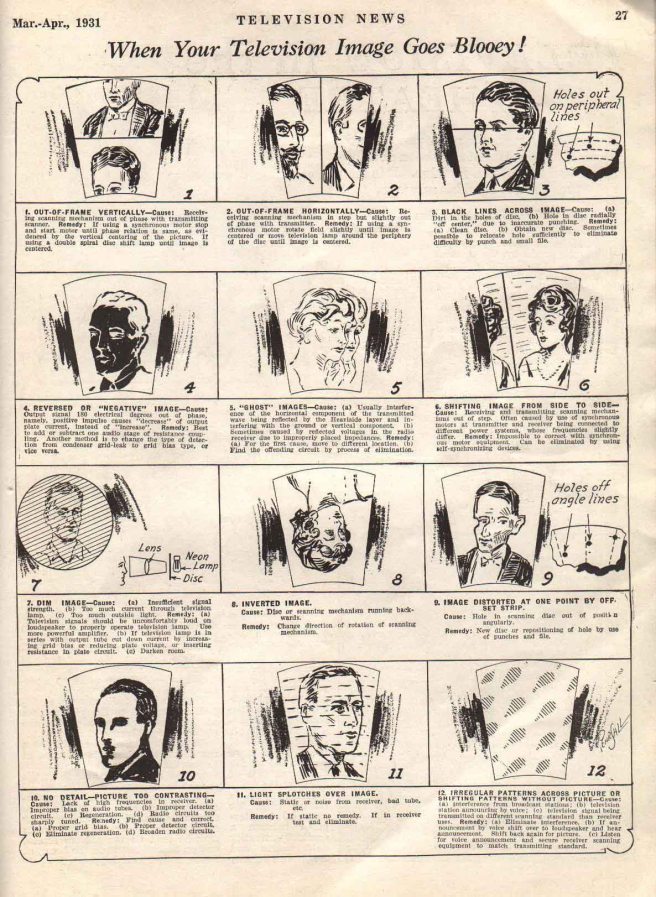
The 1932 Jenkins Universal Receiver (which needed a TV set to go along with it) cost $79.50, and came with a set of eight matched DeForest tubes. It only provided “the sound and electrical signal to drive a separate R-400 display unit,” which “housed a motor-driven pinhole scanning disc and neon lamp.”

A second universal television receiver from Jenkins was billed at $69.50 for the tubes and $13.45 for the tube equipment. Another 1932 television, from Hollis Baird, cost $39.50 for the entire get-up.
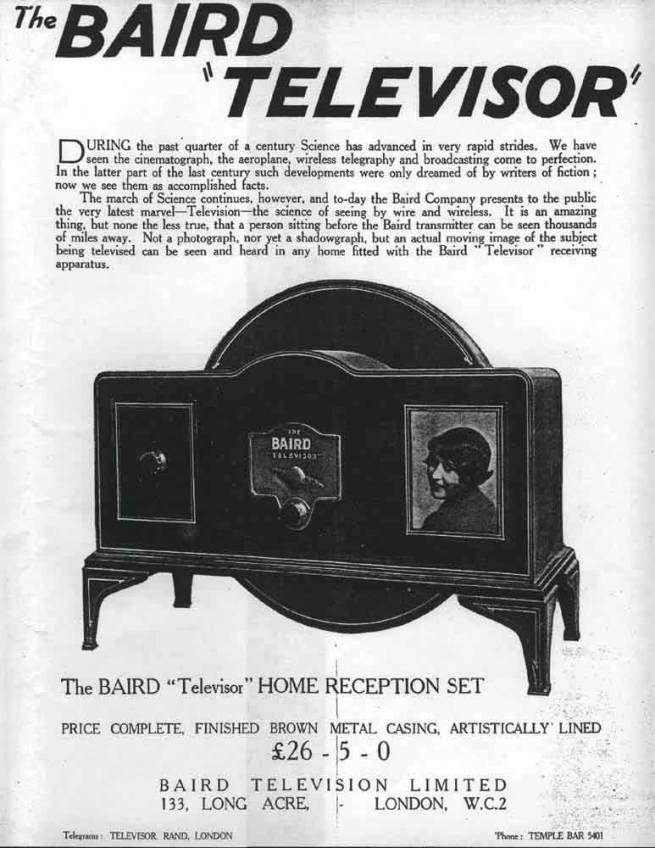
Early electronic televisions tended to be much more expensive, such as the $595 top-of-the-line model from Andrea. This beauty featured a phonograph and radio. Andrea’s cheapest sets started at $80.

DuMont models were $395 and $435. RCA went from $199.50–$600. Chicago’s Western Television Co.’s gorgeous 1929 model, with a 17-inch scanning disc (pictured below), cost $88.25 for the basic kit, another $20 for the actual cabinet, $85 for the companion receiver, and $20 for the consolette table. Also known as an echophone, between 250–300 were made, “probably more than any other mechanical set in the U.S.” At least 20 have been accounted for.

Mechanical television ultimately failed because of the poor picture quality. Often the reception suffered from fading and ghosting, and only hobbyists and the rich had time for it. With early electronic TV, it was both the high price and the abrupt halt to the television industry caused by the war. However, injured GIs had TV in their hospitals.
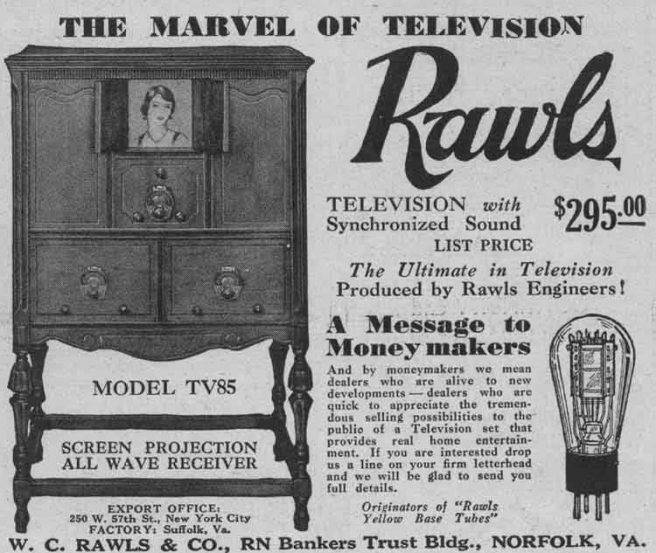
Some other beautiful models I’d love to have:

1939 DuMont 180. At least six are verified.

RCA 60-line, early Thirties. At least five are accounted for.
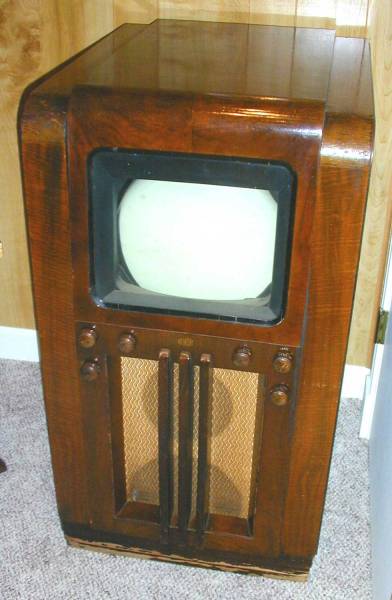
1941, DuMont 183. At least five have been verified.

1932 Jenkins receiver kit. At least two have survived.

Model 26 Televisor, Baird receiver (1929–32, England). At least three have been accounted for.
Early Television Foundation and Museum
Television History
The Dawn of TV
Do you like antique TVs? Do you own any? Have you seen any in person? If you had one, would you attempt to restore it, or just use it for decoration?

They were outrageously expensive for their time. No wonder people tried to build their own.
LikeLike
Yes, one of the reasons TV failed was because it was the Great Depression. Normal people didn’t have that kind of disposable income laying about.
LikeLike
This was such an immensely fascinating, enjoyable post. I learned a lot of great new facts and figures (e.g., how many of a certain model are known to still be in existence) about the early history of TV and lapped up every informative word.
I’ve always really enjoyed vintage TV sets as well and in fact, one of the first that I owned when I lived on my own as a teenager (I moved out of my parent’s house at the age of 16), was a classic wooden mid-century model that I bought at a thrift store. It weight a ton, but still worked like a charm and had such a cozy sense of nostalgia about it.
Thank you for this awesome post!
xoxo ♥ Jessica
LikeLike
I’m glad to hear you enjoyed the post! This was one of the posts I was happiest to recover after my Angelfire site was deleted without warning, when many of the files were still available in cache searches.
LikeLike
This is it.🙂. No record player. Otherwise this is the one. It’s in good shape for its age. Not sure if I would sell it but I would be curious to know what its value is? It’s apparently from 1929 and it is very very heavy LOL. My mother’s side of the family listen to the bombing of Pearl Harbor on this Andrea radio.
LikeLike
Fascinating. I’d never much considered the history of the television, but I suppose it would go through an evolution, just like every other electronic device. Super cool post!
LikeLike
If my uncle didn’t dispose of it when my grandfather died, there is this amazing old cabinet television/radio/recordplayer combo-cabinet that I’ve always wanted to see if I could make work. It’s huge but I don’t know much else about it (my grandparents were big believers in the “hands off, it’s broken” mindset… horrifically so sometimes).
If it’s still there, I will take down as much info as I can and take pictures. At the very least, you may find it somewhat interesting.
LikeLike
That definitely sounds like an awesome possession. My paternal grandparents also had a large radio, though I can’t recall if it ever worked in my lifetime. There’s also the radio (which I so hope my aunt didn’t sell!) my grandpap found after the war in Europe, an international radio with swastikas and Nazi eagles on it. He carried it all around Europe with him instead of sending it home, since he didn’t want it to get lost or stolen en route. For obvious reasons, we weren’t sure anyone would want to restore it.
LikeLike
There would probably be someone who would want to restore it solely for the historical value..
It’s kind of amazing the stuff that we treasure now that our families once saw as trash. That’s the same all through history though…
LikeLike
Interesting post! I love that these beautiful old radios and TV sets are being repurposed as vintage furniture. the wood and craftsmanship are amazing.
LikeLike
I own the 1929 TV . Mine is the same as the one in the picture. The top lifts up with the mirror. Mine has no record player. It’s in good shape for its age.
I would like to know the value. Not sure I would sell it. My mother’s family purchased in 1930
Apparently the listened to the Andrea radio wben Perl Harbor happened.
LikeLike